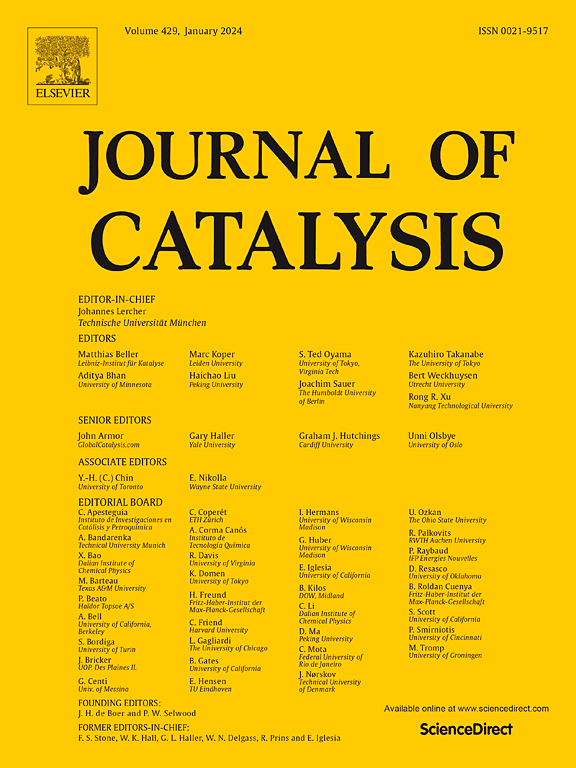一种高度稳定的金属盐基金属有机框架电催化剂,用于多功能氧化有机转化
IF 6.5
1区 化学
Q2 CHEMISTRY, PHYSICAL
引用次数: 0
摘要
作为有机合成的关键中间体的环氧化物和醛的生产通常受到有毒、腐蚀性或爆炸性氧化剂的消耗的影响。烯烃和醇的电化学氧化已被提出作为绿色、原子经济和可持续的合成方法,但由于选择性低和稳定性差,缺乏高效的电催化剂,严重限制了潜在的工业应用。本文中,我们合成了一种化学稳定的金属-有机骨架fficn -24,它由ni8 -吡甲酸酯二级构建单元和Mn(salen)衍生配体构成,作为烯烃环氧化和醇氧化反应的活性和选择性电催化剂。FICN-24在广泛的烯烃和原醇底物的电化学氧化中,对所需的环氧化物和醛类产物的收率和选择性分别高达 >; 90 %,并且在回收后保持其结构完整性和催化活性。这项工作建立了基于mof的电催化作为选择性有机转化的有前途的平台,促进了符合绿色化学原则的可持续合成。本文章由计算机程序翻译,如有差异,请以英文原文为准。


A highly stable metallosalen-based metal–organic framework electrocatalyst for versatile oxidative organic transformations
Production of epoxides and aldehydes as key intermediates for organic synthesis usually suffers from the consumption of toxic, corrosive or explosive oxidants. Electrochemical oxidation of alkenes and alcohols have been proposed as alternative green, atom-economic and sustainable synthetic methods, yet the lack of efficient electrocatalysts severely limits potential industrial applications due to the low selectivity and poor stability. We herein present the synthesis of FICN-24, a chemically stable metal–organic framework constructed from Ni8-pyrazolate secondary building units and Mn(salen)-derived ligands, as an active and selective electrocatalyst for alkene epoxidation and alcohol oxidation reactions. FICN-24 showed high yields and selectivity up to > 90 % towards the desired epoxide and aldehyde products in the electrochemical oxidation of a broad scope of alkene and primary alcohol substrates, respectively, and retained its structural integrity and catalytic activity upon recycling. This work establishes MOF-based electrocatalysis as a promising platform for selective organic transformations, advancing sustainable synthesis in alignment with green chemistry principles.
求助全文
通过发布文献求助,成功后即可免费获取论文全文。
去求助
来源期刊

Journal of Catalysis
工程技术-工程:化工
CiteScore
12.30
自引率
5.50%
发文量
447
审稿时长
31 days
期刊介绍:
The Journal of Catalysis publishes scholarly articles on both heterogeneous and homogeneous catalysis, covering a wide range of chemical transformations. These include various types of catalysis, such as those mediated by photons, plasmons, and electrons. The focus of the studies is to understand the relationship between catalytic function and the underlying chemical properties of surfaces and metal complexes.
The articles in the journal offer innovative concepts and explore the synthesis and kinetics of inorganic solids and homogeneous complexes. Furthermore, they discuss spectroscopic techniques for characterizing catalysts, investigate the interaction of probes and reacting species with catalysts, and employ theoretical methods.
The research presented in the journal should have direct relevance to the field of catalytic processes, addressing either fundamental aspects or applications of catalysis.
 求助内容:
求助内容: 应助结果提醒方式:
应助结果提醒方式:


